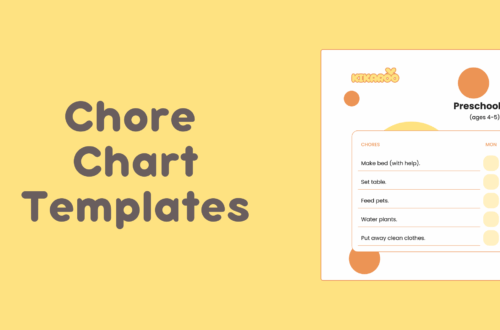Every parent dreams of smoother routines, and a chore calendar for families can make it happen. Instead of daily reminders or forgotten chores, a clear family calendar helps everyone stay organized, share responsibilities, and reduce stress at home.
Ever promise yourself that this week will be different. That the kids will actually remember to take out the trash, set the table, or feed the dog. Only to end the week doing most of the jobs yourself? You’re not alone. Parents juggle work, school, activities and the daily chaos of family life, and without a clear plan chores turn into nagging, arguments, and resentment. That’s why creating a chore calendar that works isn’t just about neatness: it’s about teaching responsibility, building independence, and reducing friction so family life runs smoother.
Want a ready-made starting point? Download our free printable chore charts by age to jumpstart your calendar: Free printable chore charts by age.
Why a chore calendar matters
Routines and predictable family structures give kids stability and help them develop self-regulation and executive function. Research on family routines finds consistent benefits for child well‑being, emotional security, and daily functioning (see Fiese et al., 2002). The Harvard Center on the Developing Child also highlights that predictable routines support a child’s ability to manage emotions and focus, skills that matter for school and life.
In short: a thoughtfully designed chore calendar reduces daily negotiation, increases kids’ independence, and helps parents move from doing to coaching.
Creating a Chore Calendar for Families That Works: Step-by-step
A well-structured chore calendar for families creates consistency and helps kids see their progress over time. Below is a practical, scannable guide to build a choreography of chores that fits your family rhythm. Use each step as a checklist when you set up your calendar.
1. Start with age-appropriate tasks
- Preschool (2-4): Put toys away, help feed pets with supervision, wipe a small table.
- Early elementary (5-7): Make bed, set/clear dishes, water plants, put laundry in hamper.
- Older elementary (8-11): Fold simple laundry, take out trash, load/unload dishwasher, sweep.
- Teens (12+): Trash/recycling routine, meal prep, grocery list help, yard work.
Not sure what fits which age? Check our chores by age guide for more detailed suggestions and how to scale responsibilities.
2. Decide frequency: daily, weekly, or one-off
- Daily: Tasks that keep the household running (e.g., dishes, pet care).
- Weekly: Bigger jobs that don’t need daily attention (e.g., vacuum, bathroom clean).
- One-off: Seasonal tasks or special projects (e.g., garage clean-out).
3. Use a visual calendar format
- Whiteboard/printed calendar for the fridge, or a digital family calendar/app.
- Color-code by child or chore type to reduce confusion.
- Include icons for non-readers (star for reward, paw for pet duties).
4. Assign roles – not just tasks
Rotate key roles weekly so kids learn variety (e.g., dish leader, laundry helper, trash monitor). Roles build ownership beyond a single task.
5. Keep time and effort realistic
Short daily tasks work best for younger kids. If a chore regularly takes too long, break it into smaller steps or swap it for something age-appropriate.
6. Build in natural consequences and incentives
Natural consequences (e.g., unwashed lunchbox) teach cause and effect. For motivation, prefer praise and privilege-based rewards over purely monetary incentives. For more on motivation strategies, see our post about how to motivate kids.
7. Trial and adjust
Run your calendar for two weeks, then regroup. Keep what’s working; tweak what isn’t. Flexibility matters, the calendar is a tool, not a rulebook.
Need printable versions to pin to the fridge? Grab our family-ready templates: Free printable chore charts by age.
Top chores to include by age (quick checklist)
Use this quick checklist to populate your calendar. Pick 3–5 tasks per child to start.
- Preschool: Toy pick-up, put clothes in hamper, feed pet with help.
- 5-7: Make bed, clear plate, wipe table, sort recycling.
- 8-11: Empty dishwasher, take out trash, pack own backpack, basic meal helper.
- 12+: Laundry from start to finish, meal prep for family, mow lawn, babysit siblings for short periods.
Common mistakes and tips to avoid them
1. Overloading the calendar
Start small. Too many tasks → burnout for kids and parents. Aim for consistent completion rather than perfect coverage.
2. Making it all about rewards
Short-term rewards can jumpstart habit formation, but long-term motivation grows from pride, belonging, and responsibility. Use rewards sparingly and pair with meaningful feedback.
3. Vague instructions
Define “make bed” (e.g., smooth sheets, place pillows) so kids know when a job is truly done.
4. Inconsistent follow-through
The calendar only works if adults stick to consequences and praise. Be consistent with check-ins and transitions.
Tracking chores – digital help with the Kikaroo app
Paper calendars are great, but if your family is busy and on-the-go, a chore tracker app can automate reminders, record completions, and make responsibilities feel like a team effort. Kikaroo brings chores, rewards, and family routines into one place so kids can track tasks and parents can coach progress without constant reminders.
Ready to try a modern chore calendar? Explore Kikaroo and set up a shared, interactive chore calendar for your family: Kikaroo app.
Internal links & further reading
- Need age-appropriate ideas to fill your calendar? See our chores by age guide.
- Want strategies to reduce nagging and conflict? Read our tips to make chores easier.
- Looking for digital tools and comparisons? Check out our overview of chore chart tools and apps.
Research & psychology (quick citations)
- Fiese, B. H., et al. (2002). Family routines and rituals provide a context for healthy child development. For a review, see: Family Routines and Rituals (PMC).
- Harvard Center on the Developing Child – predictable routines support self-regulation and executive functioning: The Science of Early Childhood Development.
FAQ snippet
How often should we update our chore calendar?
Review it every 2-4 weeks for young kids and monthly for older kids. Adjust tasks as skills and schedules change.
Should chores be paid?
Chores that are part of contributing to family life are best treated as responsibilities; occasional paid tasks (extra yard work, long projects) can be used to teach money management.
What if my child refuses to do chores?
Start with small, clearly defined tasks, model behavior, and set consistent, calm consequences. For motivation techniques, see our article on how to motivate kids.
Conclusion
Whether you use an app or a printable version, a chore calendar for families can transform daily routines into teamwork. Creating a chore calendar that works turns daily friction into predictable routines that build responsibility and independence. Start small, make tasks age-appropriate, and use visual or digital tools so the whole family knows the plan. If you want a quick launching point, download our free printable chore charts by age, then move to Kikaroo to track chores seamlessly on the go: Get Kikaroo. With a clear calendar, chores become practice for life skills, not just another thing to nag about.

 Home
Home Features
Features Testimonials
Testimonials Downloads
Downloads FAQ
FAQ Blog
Blog








